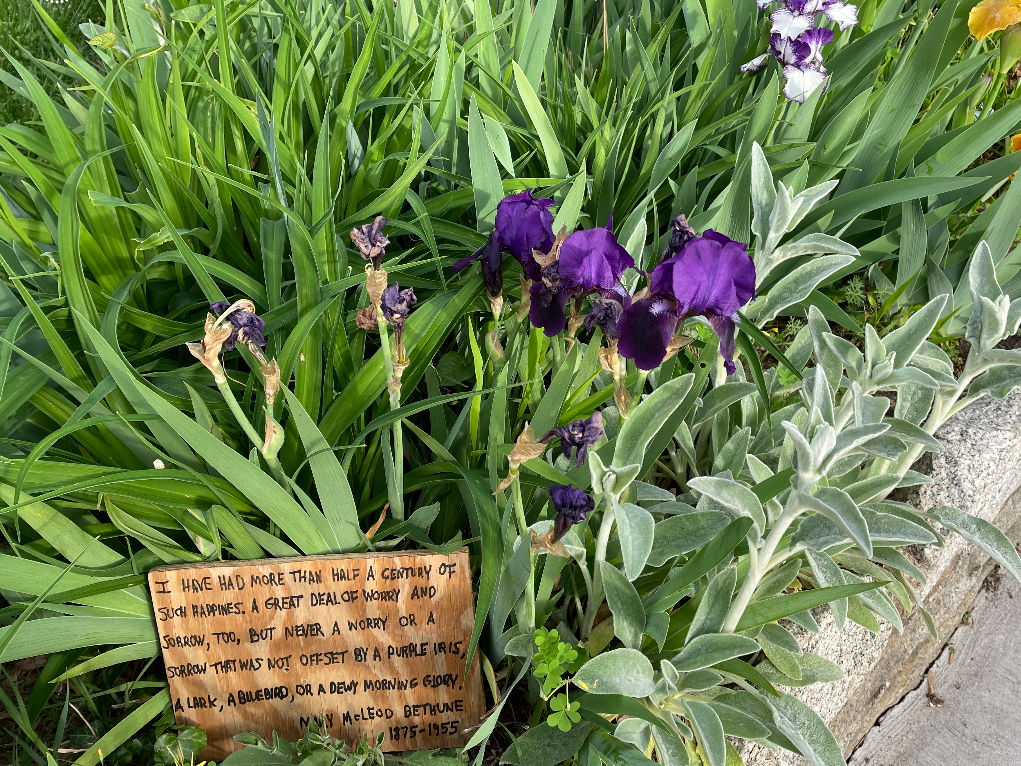Yesterday morning I was on a walk through my Silver Spring neighborhood when I came upon a tiny handmade sign among some flowers. Since it is my custom to always read the plaque, I stopped to investigate.
The little plaque reads:
“I have had more than half a century of such happiness. A great deal of worry and sorrow, too, but never a worry or a sorrow that was not offset by a purple iris, a lark, a bluebird, or a dewy morning glory.”
Followed by the name and dates of the author:
Mary McLeod Bethune, 1875-1955
And as I looked up, I noticed that it sat among a stand of beautiful irises in full bloom.

I’ve always had a special place in my heart for the old-fashioned iris. They were my mother’s favorite flower, and we always had some in our backyard on East Main Street. So I’m glad to know that I share at least one thing with the great educator and civil rights pioneer Mary McLeod Bethune.
Here’s some of her bio from the National Women’s History Museum:
“The daughter of formerly enslaved parents, Mary Jane McLeod Bethune became one of the most important Black educators, civil and women’s rights leaders and government officials of the twentieth century. The college she founded set educational standards for today’s Black colleges, and her role as an advisor to President Franklin Delano Roosevelt gave African Americans an advocate in government . . .
A champion of racial and gender equality, Bethune founded many organizations and led voter registration drives after women gained the vote in 1920, risking racist attacks. In 1924, she was elected president of the National Association of Colored Women’s Clubs, and in 1935, she became the founding president of the National Council of Negro Women. Bethune also played a role in the transition of Black voters from the Republican Party—“the party of Lincoln”—to the Democratic Party during the Great Depression. A friend of Eleanor Roosevelt, in 1936, Bethune became the highest ranking African American woman in government when President Franklin Roosevelt named her director of Negro Affairs of the National Youth Administration, where she remained until 1944. She was also a leader of FDR’s unofficial ‘black cabinet.’ In 1937 Bethune organized a conference on the Problems of the Negro and Negro Youth, and fought to end discrimination and lynching. In 1940, she became vice president of the National Association for the Advancement of Colored Persons (NAACP), a position she held for the rest of her life. As a member of the advisory board that in 1942 created the Women’s Army Corps, Bethune ensured it was racially integrated. Appointed by President Harry S. Truman, Bethune was the only woman of color at the founding conference of the United Nations in 1945. She regularly wrote for the leading African American newspapers, the Pittsburgh Courier and the Chicago Defender.“
In addition to being a civil rights pioneer and educator, Bethune was a businesswoman who has been honored with a memorial statue, a postage stamp, and—in 2022—she became the first African American to be represented with a state statue in the National Statuary Hall Collection at the U.S. Capitol.
It gives me great joy to know that such an amazing and transformational leader took the time to stop and admire the iris. And a dewy morning glory.
More to come . . .
DJB




Pingback: Observations from . . . April 2024 | MORE TO COME...